
VALUES + QUOTES ON BEER.
THE TWELVE BEER BOTTLE VALUE FACTORS
While
there is no substitute for experience, understanding the value of and
beer bottle. Any one of these factores is frequently not sufficient in
and of itself to make a beer bottle valuable. It is a combination of these factors that can determine the value.
* 1. Supply and demand
* 2. age
* 3. rarity
* 4. condition
* 5. color
* 6 esthetic appeal
* 7. embossing and design (labels)
* 8. category (what brewery, town)
* 9. size, shape
* 10. individuality
* 11. historic significance
* 12. locale (your own town or state)
Talk
to as many people that you can and read as many books that you can
find. What is worth alot to you may not be worth anything in the
collecting world. Rarity is the hardest one for me to determine. Alot of
beer bottle breweries, do short term brewing.They may only make beer
for the area they are in. These days Beer bottles most of the time are
clear or brown, that is it. The cost to make other colors is just to
much. Condition makes alot of differance. Labels, chips, or cracks are
looked at the most under Rarity. Alot of beer bottle collectors will buy
a bottle in any condition they can at a good low price untill they find
a better one to take it's place. Some beer bottle collectors only
collect certain Categories like lets say, Chicago beers, NY beers, UK
beers, Japan beers, Sacramento beers, or beer bottles that have birds,
dogs, airplanes, bridges, lakes, I collect all. I have not category that
I go by. If it looks good and I want it I get it.
EXTREMELY RARE ----------- ONLY FIVE TO 10 EXIST
VERY RARE-------------------- ONLY 10 TO 20 EXIST
RARE----------------------------20 TO 40 EXIST
VERY SCARCE-----------------NO MORE THAN 50 EXIST
SCARCE------------------------NO MORE THEN 100 EXIST
________________________________________________________________________________________________________________________________
THE PROHIBITION YEARS
The
passing of a bill in 1919 to outlaw alcoholic drinks was, of course, a
hammer-blow to brewers in the US. Some kept going by brewing 'near beer'
making non-alcoholic drinks such as malted milk and soda, even making
cheese. A year the repeal of prohibition in 1933, only 756 breweries had
reopened. By 1940 beer production was at preProhibition levels, but
with only half the number of breweries.. Mergers and takovers were
thinning out the breweries that had survived. Between 1949 and 1958, 185
American breweries closed or sold out. By 1961 there were only 230
breweries in operation, of which just 40 were independently-owned. In
1977 the number had fallen to fewer than 100.
________________________________________________________________________________________
US BEER LABEL DATING
Government Warning:
(1) According to the Surgeon General women should not drink alcoholic
beverages during pregnancy -etc. This statement dates a label as 1989+.
Multiple Breweries listed:
You can often zero in on a time period based on the cities listed and
the opening/closing dates of the corresponding breweries.
Opening/closing dates for the Anheuser-Busch, breweries illustrate:
| St Louis, MO |
1870 - date |
Jacksonville, FL |
1969 - date |
| Newark, NJ |
1951 - date |
Merrimack, NH |
1970 - date |
| Los Angeles, CA |
1954 - date |
Williamsburg, VA |
1972 - date |
| Miani, FL |
1959 - 1961 |
Fairfield, CA |
1976 - date |
| Tampa, FL |
1959 - date |
Baldwinsvifle, NY |
1983 - date |
| Houston, TX |
1966 - date |
Fort Collins, CO |
1988 - date |
| Columbus, OH |
1968 - date |
|
|
An
A-B label, or any collectable for that matter, which lists only St.
Louis, Newark and Los Angeles, may be estimated as circa 1954-59, since
neither Miami or Tampa are mentioned. Likewise, ten cities ending in
Fairfield would date an item as circa 1976-83
Internal Price Code markings date a label as 1973+, but not all 1973+ labels carry IPC markings.
ZIP Codes date a label as 1965+, but not all 1965+ labels carry zip codes.
Foil Paper Labels began to be popular in the late 1940's.
Dates:Some labels are perforated, stamped or printed with the date of production.
IRTP Labels:
The Internal Revenue Tax Paid statement was required on labels from the
end of prohibition,1933, until March of 1950. Removal was generally
sharp, however, a few IRTP labels used as late as 1953 have been found.
Thus, IRTP labels are c1933-50.
U-type permit numbers were required on beer labels from the end of prohibition, 1933, to
September 1935. However, notification to remove permit numbers was slow
and brewers were allowed to use up existing label inventories. Many
permit numbers were dropped during 1936, however exceptions as late as
1941 can be found. U-type permit labels are generally considered
c1933-36. Occasionally you run across a label with a U-type permit
without the IRTP statement; an obvious error that the federal label
examiner would be quick to jump on. Labels which show a U-type permit
number but not the brewery of origin can usually be traced by the permit
number. For example, Dad's Beer, Bottled for 905 Liquor Stores, St.
Louis, MO, Permit MO. U-920 can be traced to the Peerless Brewing Co. of
Washington, MO through the permit no.
Jody Farra & Phil Myers book The Post Prohibition Brewery Guide 1933-1983 lists the permit numbers that the Treasury Department has on file, but
the file is incomplete. Its fun to add to these lists from old beer
labels. Here is an example for the state of Missouri,
| U-900 |
Anheuser-Busch, Inc |
St. Louis |
| U-901 |
Falstaff Brewing Corp. Forest Park Blvd |
St Louis |
| U-902 |
M. K. Goetz Brewing Co. |
St. Joseph |
| U-903 |
Griesedieck Bros. Brewery Co. |
St Louis |
| U-905 |
Fischbach Brewing Co. |
St. Charles |
| U-906 |
Schorr-Kolksclneider Brewing Co. |
St. Louis |
| U-907 |
Falstaff Brewing Corp. Michigan Ave |
St. Louis |
| U-908 |
Capitol Brewery Co |
Jefferson City |
| U-909 |
Appleton Brewery & Ice Co |
Old Appleton |
| U-910 |
Imperial Brewing Co. |
Kansas City |
| U-911 |
Louis Obert Brewing Co. |
St Louis |
| U-912 |
Hyde Park Breweries Assn., Inc. |
St. Louis |
| U-913 |
Carondelet Brewing Co |
St. Louis |
| U-917 |
McGovern Brewery Co. |
Old Appleton |
| U-918 |
A. B. C. Brewing Corp |
St. Louis |
| U-920 |
Peerless Brewing Co. |
Washington |
| U-921 |
Crescent Brewing Co. |
Marionville |
Numbers
U-900 to U-913 were listed in Jody and Phil's book. The others were
added from old label finds. I really get a buzz when I identify a new
permit number. I'm getting older!
Prohibition Labels:
The feds referred to the near beer produced during prohibition as
Cereal Beverages. Cereal Beverages could not use the word Beer on the
label and had to carry the less than 1/2 of 1% alcohol content
statement. L-type permit numbers appeared on Cereal Beverages starting
around 1928. I'm not sure when they stopped; it may also have been
around 1936, however its a moot point as most brewers dropped cereal
beverages in favor of the real thing as soon as prohibition ended. Its
safe to generalize prohibition labels with L-type permits as c1928-33
and prohibition labels without L-type permits as c1920-1928. Just
remember there are exceptions. A few brewers continued to produce cereal
beverages afler prohibition. Jacob Schrnidt of St. Paul and M. K. Goetz
of St. Joseph, MO offer examples of L-type permit labels in the 1933-35
period and both continued to produce less than 1/2 of 1% alcohol
beverages (w/o L-permits) well after 1935. See more below.
Pre-Pro Labels:
Obviously, these date prior to 1920. Labels which carry the Guaranteed
by the Pure Food and Drugs Act offune3o, 1906 statement seem to be
c1906-12. Labels that list the size and/or alcohol content are generally
1912+ and sometimes later as the start date for this information seems
to vary state to state. Pre 1900 labels can usually be identified by
their distinctive lithography style. See more below.
Copyright © 1991 Bob Kay
____________________________________________________________________________________________________________________________
More on World War I-Prohibition-Early Repeal Labels
____________________________________________________________________________________________________________________________
World War I, Prohibition and Repeal led to some quite interesting
changes in US beer labeling. It's fun to study these changes and learn
how to read and date your labels. New information is presented since
this subject was first discussed in the Collectors Comer of BL1.
Prohibition Labels:
First lets study the onset of prohibition. The declaration of war with
Germany(1917) and the final push for prohibition came almost
simultaneously. All US distilleries were closed down in August 1917 by
the wartime Food Control Law and in December1917 the alcoholic content
of beer was limited to 2.75%w by presidential decree - another wartime
conservation measure. The 18th Amendment which decreed national
prohibition was ratified during January 1919 to take effect one year
later, and the Volstead Act which established methods of enforcing
prohibition passed later in 1919. At first a few brewers were licensed
to produce higher alcohol beers for medicinal purposes but the dry
forces moved quickly to stop this with the Willis-Campbell bill which
passed November 1921.
As early as l9l6-l7 the merits of cereal
beverages(1/2of 1% v) were being touted as the reality of national
prohibition began to sink in. After all, 25 states were already dry so
the national market for beer was quickly shrinking.
During December 1917 the alcoholic content ofbeerwaslimitedto2.75% as aWorld War I conservation measure; c1918-1920.
Fancy
Descriptions such as Full Pre-War Strength were prohibited by Beer
Labeling regulationspassed March1935. Curiously, this statement on a
1934-35 label referred to pre-1918 WorIdWarIbeer'.
Anheuser-Busch introduced Bevo,
its new nonalcoholic beverage, in 1916 and elsewhere the flood of
cereal beverages (near beer) wer introduced during the 1917-18 period.
These included such brand names as Pablo from Pabst, Famo from Schlitz, Chrismo from Christian Moerlein, LUX-O from Stroh's, Tivoline from Tivoli-Union, Mannah from Coors and so on. These gradually replaced the real brew as the
various states succumbed to prohibition and the national brewers tried
to prepare for the inevitable.
Labels showing the wartime alcohol
level of 2.75% are not common. Off hand, the Jacob Ruppert examples are
the only ones I can think of. Ruppert pushed hard to get the 2.75% w
alcohol level defined as nonalcoholic but the dry forces would have none
of it and the level of 0.5% v prevailed. Also, the effort to produce
beer for medicinal purposes was almost stopped before it got started.
The Schlitz label pictured in the Collectors Corner of BL5 is the only
example that comes to mind. In 1924 an effort was made to sell Malt
Tonic's with 2% alcohol and 12% solids. These were intended to be sold
in drug stores with doctors prescriptions. After a few months the dry's
were successful in getting the solids content raised to 18% which
resulted in a syrupy product too heavy to drink as a beverage.Throughout the prohibition era a variety of malt tonic and cereal
beverage products were tried but these generally met only limited
success. Examples of prohibition Malt Tonic labels with a variety of
alcohol and solid contents can be found. Those with the H-type permit
number denote a higher alcohol content, Cereal beverage labels were
notable in that the word beer was prohibited on the label and the
alcohol content was shown as not more than 1/2 ofl%v. Sometime around
1928 Federal L-typepermit numbers (L#) began to appear on cereal
beverage labels.
Early Repeal Labels: Now
lets study the onset ofrepeal and the effect on beer labeling. As a
result of the Cullen-Harrison Act, 3,2% w (or 4% v) beer could be sold
starting April 7, 1933 in the twenty states that had repealed
prohibition. The remaining states fell into line fairly quickly with
Kansas being the last in 1937. However, the return of beer couldn't have
come at a worse time. The country was in the middle of the great
depression and the resources to restart a business which had been mostly
dormant for 13 years were not easy to come by. Of course, the success
of the bootleggers gave the impression that brewing would be instantly
profitable, and everybody and his brother wanted in on the instant
riches. However, the harsh realities of prohibitions effect on the
brewing industry coupled with the depression were all too obvious when
by June 1933 only 31 breweries were back in business. However, the lure
of brewing was overpowering and twelve months later the number had risen
to a whopping 756! By December, 1933 the 21st Amendment was ratified
and all federal restrictions on the alcohol limit of beer were removed.
This led to a temporary horsepower race with alcohol contents. while it
was generally agreed that a beer with about 4.5% alcohol was most
palatable. Demand for beer with a kick led to higher and higher alcohol
contents and of course all kinds of advertising claims to accompany
them. However, it didn't take long before complaints about flavor and so
on led to a general retreat in alcohol levels to the more palatable
4.5%ish levels. Repeal labels had to show the Internal Revenue Tax Paid
(irtp) statement and the U-type federal permit number (U#). By March
1.1935 new beer labeling regulations were passed which eliminated fancy
descriptions appearing on labels such as extra strength, high test, high
proof, full old time alcohol strength, prewar strength, bonded,
certified, and so on. About the same time the requirement to show permit
numbers on labels was rescinded, although implementation dragged out
for some time after that.
I have often puzzled over early repeal
labels that claimed prewar strength.Since the last war started in 1917
and US involvement lasted only 18 months, it seemed a little late to be
referring to that war. However, these claims are clearly referring to
beer like it was before the December 1917 restrictions on the alcoholic
content of beer. I guess subconsciously, they would like to think that
the wartime restrictions plus the 13 years of prohibition from 1920 to
1933 didn't really happen. I'm sure the claim was understood by the old
time brewers, but to the beer buying public, I wonder? In any event the
new beer labeling restrictions of March 1935 put a quick end to a wide
range of fancy claims that were outgrowth's of unrestricted repeal beer.
Prohibition label dating:
c1916-28 w/o L#, ½ of 1%, the word beer prohibited
c1928-33 with L# ,½ of 1%, the word beer prohibited
c1918-20 Wartime Beer, nmt 2.75% w, non-intoxicating
c1920-21 Prohibition Beer, For medicinal purposes only
Repeal label dating:
Apr33 to Dec 33, irtp, U#, not more than 3.2% w (4% v) only!
Jan 34 to Mar35, irtp, U#, No alcohol limits, Fancy descriptions allowed.
Mar 35 toDec 36, irtp, U#, no alcohol limits, No fancy descriptions
Jan 37 to Mar50, irtp, No U#, No alcohol limits, No fancy descriptions
THE FIRST HOP BEER
A recreation of an ale from 1503, based on a recipe in a book by RICHARD
ARNOLD called Customs of London, Is the earliest example of a beer that
genuinely used hops. The original ingredients were
listed as 10 quarters of malt, 2 quarters of wheat, 2 quarters of oats,
and 40 pounds of hops to make
60 barrels of beer.
Home0brewing expert Graham Wheeler, who recreated the beer, smoked the
malt over a wood fire in a garden barbeque. ( At the time,
all
malt was kilned over wood fires.) Wheeler used Goldling hops, which did
not exist at the time but there are no sixteenth-century varieties
available
today. The beer had an original starting
gravity of 1065 degrees and a finished with 6.7 percent alcohol. As a
result of the use of wheat, the beer had a
hazy bronze
colour and a pronounced smokey and herbal aroma. There was more smoked
malt character on the palate, with a resiny underpinning from
the hops, while the finish was intensely dry and bitter with dark fruit notes.
______________________________________________________________________________________
BREWING AND BATTLES IN ANCIENT TIMES
While beer has a long history as a beverage in Sumeria, Mesopotamia
and Egypt, by the time the Roman Empire, the drink of choice around
the Mediterranean was wine. The Romans planted Vineyards wherever they
settled, and the Roman legionnaires drank wine
daily,
as did most other citizens. When Roman soldiers encountered the tribal
people of Gaul and the British Isles, however, they
found themselves battling serious beer drinkers.
To
the ancient Celts, beer was a preude to battle. The effects of alcohol
ameliorated the natural fear of injury or death in armed conflict.
The
strength of the Celtic attack lay in the ferocity of the first
onslaught. It was a power generated by a belief in the afterlife, a
desire
to gain glory, and a battle
hysteria created by the building crescendo of noise and chanting, often
enhanced still further by alcohol.
These
are, in fact the usual methods that fighting forces throughout the ages
have needed to give courage at the moment of battle.
Like
the Vikings, the Celts often fought naked. Was this a consequence of
the shedding of inhabitions brought about by beer drinking ?
As
a battle strategy, it seems to have had only limited success. Soldiers
usually keeep their clothes on these days, but beer still retains
its ability to create a fighting mood, as any bartender knows..........
MORE TO COME ....................................
_______________________________________________________________________________________
FLAVORED BEERS OF WESTERN NEW YORK
By ANN E. SPEAR.
Our first mystery bottle was found in 1968, and we soon began to
classify it as a flavored beer. After seventeen years of reseach, that
name seems to fit the classification of the type of bottle best. It
certainly isn't a mineral water, a pop or soda bottle, or a regular hops
bottle. It seems to be in a class all by itself.
An old store in
Youngstown, New York was being emptied for remodeling into apartments.
When clearing the basement of colorfull advertising posters from the
late 1800's, a quantity of old bottles embossed D. DAVIS were found. The
bottles were sapphire blue, emerald green, and one black olive-amber,
10" x 3 1/2", smooth base, and had twelve panels. As the bottles were
brought up, a relative of the D. DAVIS family saw them and took them
home, giving one or two to an antiques dealer who was with her.A few of
the bottles were dispersed among the relatives, including an entire case
of emerald green reportedly taken to the East Coast. The remaining
sapphire blue bottles and the black glass could be seen in many of the
windows of her house.
We were just begining to collect old
bottles in the mid 1960's and my husband, who was a Fuller Brush man at
the time, saw the blue bottles in the window and was able to purchase
one, then two more. Finally, shortly after the lady died, we were able
to purchase the black bottle, The remaining bottles were kept in the
family, no one knew just what they contained, but they had probably been
returnable, as they showed much wear, especially on the base.
Soon
after, a second, similar bottle embossed J.B.G. came into our
collection from a bottle collector. The collector's brother-in-law
had
found the bottle while hunting in the local woods and had given it to
her. Again, no clue to the contents, but the bottle had much wear on the
base. The bottle was also sapphire blue.
The third bottle we
found was originally dug near the Harrison Radiator Div. GMC plant in
the town of Lockport. Again, sapphire blue in color, paneled, same
dimentions, but with an iron pontiled embossed DR. CRONK, obverse R. Mc
C. Although much has been written about BR. CRONK, we have not found
reference to the initials R. Mc C. We did find a pottery bottle of the
same style embossed sapphire beer.
By 1971 we had added a
beautifull, sparkling blue flavored beer embossed M. RICHARDSON. This
bottle was very similar in style to the others, but did not have the
pannels. This bottle fell from the ceiling of a home on Chestnut Ridge
in wilson, N.Y., during remodeling. The bottle was full of a
varnish-like substance we thought it was amber. In fifteen min. we had
cleaned the bottle and found it was blue in color.
Quickly
following the purchase of the M. RICHARDSON bottle we were able to buy
another flavored beer embossed H.H.P. from a digger in Shellby, NEW
YORK. We then bought a variant to the H.H.P. embossed H.H.P. & CO.
that had been found in some woods. And finally some pieces of the puzzle
began to fall into place.
In the 1970's we belonged to an
antiques club that met at the Niagara Country Historical Society
building in Lockport. We gave a program about old bottles and at that
time met Francis Swanson, A local history buff. Visiting with Fran, we
discovered he owned a notebook filled with 68 leaves containing 267
documents from the business of M. RICHARDSON. He loaned us the book and
allowed us to photograph several of the receipts. When Fran passed away a
few years ago, we purchased the book from his widow.
The most
exciting document we found in the notebook was the bill of sale of the
H.H PARKER & CO. business to Claussa Richardson, as quuoted exactly:
"LOCKPORT: August 14, 1860.


For
and in consideration of the sum of One Hundred and Twenty Dollars to me
this day paid I hereby sell, assign and transfer all my rights title
and interest in the Beer Shop Company known as H.H. PARKER & CO. to
Claussa Richardson." This bill sale was signed H.H. Parker.
A
call to the Niagara County Historian verified a listing in the 1859
Lockport City Directory of H.H. Parker, owner of a lemon beer business
at 6 Lock Street.The call also confirmed that Claussa Richardson was the
wife of Mortimer M. Richardson, who continued to make lemon beer untill
at least 1866. The record book has numerous tax recepts to confirm
this, one read: "NO. 2270 UNITED STATES INTERNAL REVENUE Collector's
Office District of Lockport Sept. 17, 1866 Received of M.M. Richardson
Twelve 70/100 Dollars for Excise Tax on August Lemon Beer $12.70. Annual
Watch 1 $1 and (unreadable) $1. Total $14.70 being amount assessed on
August 1 for 1866. M.L. Burrell, DR. Collector."

Richardson
purchased his bottles from the Lancaster Glass Works, Lockport Glass
Manufacturing Co., Lockport Glass Works (same business location,
different proprietors), and the Whitney Glass Works. On 5/14/67 he
purchased 3 cask 1 bb1 3 86/144 quart beer bottles for $53.96 from the
Lockport Glass Manufacturing Co. Although the color of the bottles is
not mentioned, and we do not see tax records after 1866, the bill does
say QUART BEER BOTTLES.
Our collection also includes an emerald
green M. Richardson, paneled, found on Sand Hill, close to Rapids, N.Y.,
and an aqua example, no panels, found in the basement of a home in
Barker, N.Y. In 1983 we purchased an emerald green J.B.G. from a young
man named Jim who was remodeling a house on Harvey Avenue in Lockport
N.Y. in 1858. While deepening his basement, he unearthed several
fragments and one whole bottle. Jim's dad thought the bottle was
worthless and tried to throw it out. Jim knew we collected old bottles
and sold it to us, going home with enough cash to show his dad old
bottles did have worth.
Other
examples of flavored beers include a pint Boughton and Chase, Iron
pontil, ten panels, sapphire blue, dug in a garden on Route 104 between
Lockport and Gasport. Burt Spiller from Rochester kindly supplied
following from the Rochester Daily Union, Sept. 23, 1852, page 3 col.2:
"About 2 o'clock this morning a small wooden building owned and occupied
by Boughton and Chase, Situated on the Feeder nesr MT. Hope Ave., Was
totally destroyed by fire. The premises were used for the manufacture of
Cronk's Beer and Gleason's Mineral Water. The property was insured for
$1500, which, the owner say's will not cover the loss. The origin of the
fire is unknown. The building was nearly destroyed before the general
alarm had been spead." We once owned a blue E.TOUSLEY CRONK'S BEER,
twelve sided.
All of the flavored beer in our collection show
considerable wear, and were probably returnable. At one time Richardson
received credit from the Lockport Glass Works for glass culler. Although
many of our bottles were dug, they are all in very good condition.
Beer
made from the blending of various roots and barks was popular in Europe
and America since times. Ingredients could be spikened, ginger,
sarsaparilla, wintergreen, of fruits such as lemon. Yeast and sugar were
added to the flavorings and water. As the product aged the sugar were
converted into alcohol of about 2 to 5 %, the same alcohol content as
beer.
Thus we conclude that the name-flavored beer is appropriate
for this class of bottle. This category is uncommon with less then 100
examples known to us. All of the bottles we have seen came from the
local area within a hundred-mile radius covering Niagara, Orleans and
Monroe classify the bottles as flavored beers untill someone can
convince us that anouther classification is more appropriate. Below I have put several pictures of some bottles. VERY RARE FROM THE COLLECTION OF ERIC SCHMETTERLING.

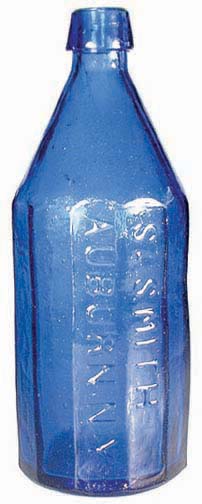
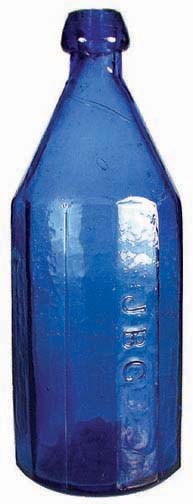
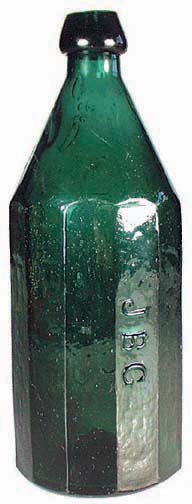
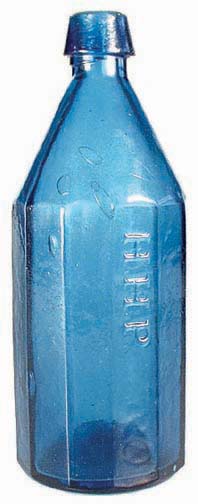
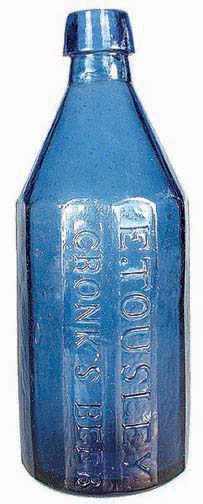
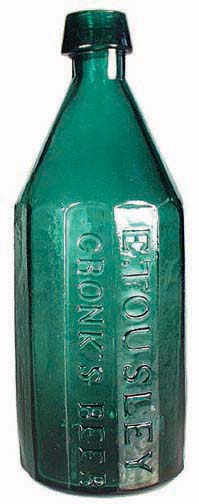
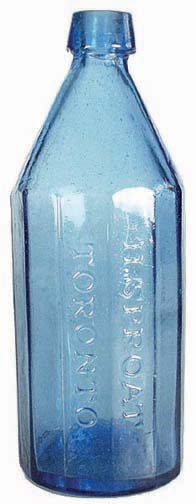
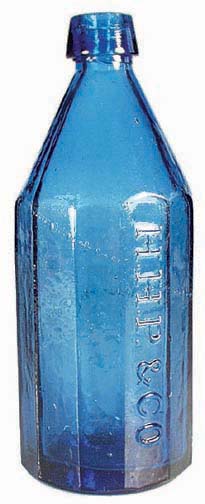

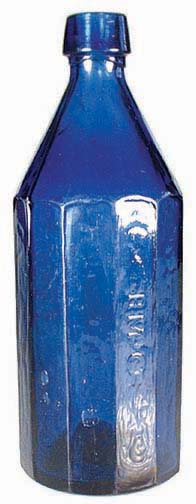

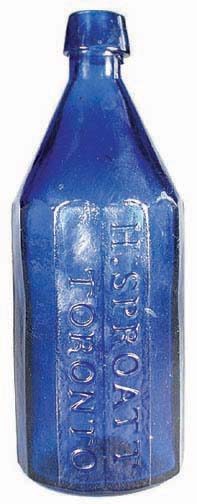
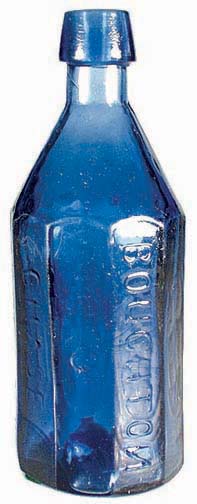
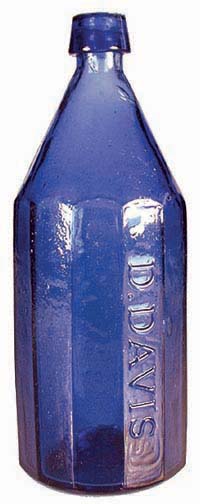





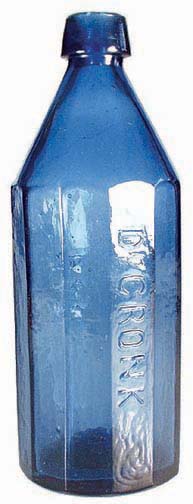
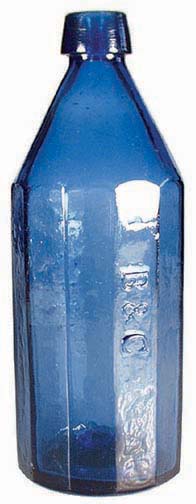

We start with the fisrt one on the very top..
1) WM COOK, GREEN (pint size)
2) S. SMITH / AUBURN, NY (cobalt blue)
3) J.B.G. (cobalt blue)
4) J.B.G. (green)
5) H.T.P. (cobalt blue)
6) E. TOUSLEY / CRONK'S BEER (cobalt blue)
7) E. TOUSLEY / CRONK'S BEER (green)
8) H. SPROUTT / TORONTO, (light blue)
9) R. GREEN / TORONTO, (cobalt blue)
10) H.H.P. & CO. (blue)
11) H.H.P. (blue)
12) RME CO. (cobalt blue)
13) D. DAVIS (black olive green)
14) H. SPROATT / TORONTO, (cobalt blue)
15) BOUGHTON & CHASE (pint size) (cobalt blue)
16) D. DAVIS (cobalt blue)
17) M. RICHARDSON (cobalt blue)
18) M. RICHARDSON (green cylinder)
19) M. RICHARDSON (aqua cylinder)
20) R. McGOUN (cobalt blue)
21) DR. CRONK (cobalt blue)
22) DR. CRONK --- RMcC (on the reverse side) (cobalt blue)
23) B & G (cobalt blue)
24) M. RICHARDSON (green)
_______________________________________________________________________________________
DO YOU NOW???????
That beer was drank form straws
made of gold??? That's right GOLD. They have found Gold Made straws in
Tombs That are well over 1,000 years old. They have also found Pictures
of male and females Seated down drinking beer out of wide-mouthed jars
Through tubes. The tubes were made of gold. They also have Reports of
people drinking beer through straws in 400bc.
"Beer is living proof that God wants us to see us happy"
By Benjaman Franklin
"The problem with some people is that when they aren't drunk they're sober"
By G.K.Chesterton.
"Beer makes you feel the way you ought to feel without beer"
By Henry Lawson
"O Beer! O Hodgson, Guinness, Allsopp, Bass! Names that should be on every infant's tongue"
By C.V. Calverley.
"24 hours in a day, 24 beers in a case. Coincidence ??
By Stephen Wright
"Beauty lies in the hands of the beer holder"
By Just sounded good.
"I will kill everyone in this room for a drop of sweet beer"
By Homer Simpson
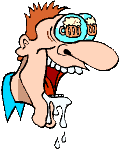
_______________________________________________________________________________________________________________________________
beer bottle collectors
We collect, sell and trade beer bottles
























